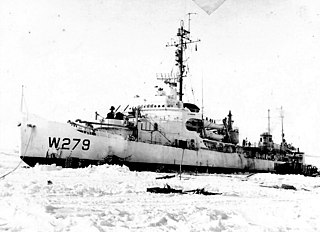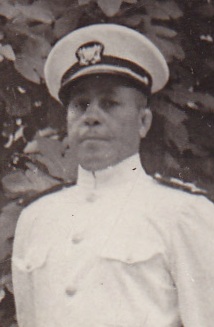
The United States Coast Guard (USCG) is the maritime security, search and rescue, and law enforcement service branch of the United States Armed Forces and one of the country's eight uniformed services. The service is a maritime, military, multi-mission service unique among the United States military branches for having a maritime law enforcement mission with jurisdiction in both domestic and international waters and a federal regulatory agency mission as part of its duties. It is the largest coast guard in the world, rivaling the capabilities and size of most navies.

The United States Coast Guard Academy (USCGA) is a service academy of the United States Coast Guard in New London, Connecticut. Founded in 1876, it is the smallest of the five U.S. service academies and provides education to future Coast Guard officers in one of nine major fields of study.

The USCG seagoing buoy tender is a type of United States Coast Guard Cutter used to service aids to navigation throughout the waters of the United States and wherever American shipping interests require. The U.S. Coast Guard has maintained a fleet of seagoing buoy tenders dating back to its origins in the U.S. Lighthouse Service (USLHS). These ships originally were designated with the hull classification symbol WAGL, but in 1965 the designation was changed to WLB, which is still used today.

The Gold Lifesaving Medal and Silver Lifesaving Medal are U.S. decorations issued by the United States Coast Guard. The awards were established by Act of Congress, 20 June 1874; later authorized by 14 U.S.C. § 500. These decorations are two of the oldest medals in the United States and were originally established at the Department of Treasury as Lifesaving Medals First and Second Class. The Department of the Treasury initially gave the award, but today the United States Coast Guard awards it through the Department of Homeland Security. They are not classified as military decorations, and may be awarded to any person.

The Island-class patrol boat is a class of cutters of the United States Coast Guard. 49 cutters of the class were built, of which 7 remain in commission. Their hull numbers are WPB-1301 through WPB-1349.

The Sikorsky MH-60T Jayhawk is a multi-mission, twin-engine, medium-range helicopter operated by the United States Coast Guard for search and rescue, law enforcement, military readiness and marine environmental protection missions. It was originally designated HH-60J before being upgraded and redesignated beginning in 2007.
The United States military inter-service awards and decorations are those medals and ribbons which may be awarded to all members of the six military branches of the U.S. Armed Forces. Each military department awards inter-service awards under the same criteria.

USCGC Northwind (WAG/WAGB-282) was a Wind-class icebreaker, the second United States Coast Guard Cutter of her class to bear the name. She was built to replace USCGC Staten Island which was in Soviet lend-lease service.
USS Manitowoc (PF-61), a Tacoma-class frigate in commission from 1944 to, was the first ship of the United States Navy to be named for Manitowoc, Wisconsin. After commissioned service in the U.S. Navy from 1944 to 1946. After her Navy service, she served in the United States Coast Guard for a few months in 1946. Sold to France in 1947, she commissioned into service in the French Navy as Le Brix (F715) in 1948 and operated as a weather ship until scrapped in 1958.

The Wind-class icebreakers were a line of diesel electric-powered icebreakers in service with the United States Navy, United States Coast Guard, Royal Canadian Navy, Canadian Coast Guard and Soviet Navy from 1944 through the late 1970s. They were very effective ships: all except Eastwind served at least thirty years, and Northwind served in the USCG continuously for forty-four years. Considered the most technologically advanced icebreakers in the world when first built, the Wind-class icebreakers were also heavily armed; the first operator of the class was the United States Coast Guard, which used the vessels for much-needed coastal patrol off Greenland during World War II. Three of the vessels of the class, Westwind, Southwind, and the first Northwind all went on to serve temporarily for the Soviet Union under the Lend-Lease program, while two others were built for the United States Navy and another was built for the Royal Canadian Navy; all eight vessels were eventually transferred to the United States Coast Guard and the Canadian Coast Guard.

USS Samuel Chase (APA-26), launched as SS African Meteor, was an Arthur Middleton-class attack transport manned by the United States Coast Guard during World War II. She was named after Founding Father Samuel Chase, a signatory to the Declaration of Independence.

USCGC Waesche (WMSL-751) is the second Legend-class cutter of the United States Coast Guard.

USCGC Eastwind (WAGB-279) was a Wind-class icebreaker that was built for the United States Coast Guard. Completed in time to see action in World War II, she continued in USCG service under the same name until decommissioned in 1968.

The T. A. Gillespie Company Shell Loading Plant explosion, sometimes called the Morgan Munitions Depot explosion or similar titles, began at 7:36 pm EDT on Friday, October 4, 1918, at a World War I ammunition plant in the Morgan area of Sayreville in Middlesex County, New Jersey, United States. The initial explosion, generally believed to be accidental, triggered a fire and subsequent series of explosions that continued for three days, totaling approximately six kilotons, killing about 100 people and injuring hundreds more. The facility, one of the largest in the world at the time, was destroyed along with more than 300 surrounding buildings, forcing the evacuation and reconstruction of Sayreville, South Amboy, and Laurence Harbor. Over a century later, explosive debris continues to surface regularly across a 1.2-mile (1.9 km) radius.

USS Cook Inlet (AVP-36) was a United States Navy Barnegat-class small seaplane tender in commission from 1944 to 1946. She tended seaplanes during World War II in the Pacific and earned one battle star for her service. After the war, she was transferred to the United States Coast Guard, and was in commission as the Coast Guard cutter USCGC Cook Inlet (WAVP-384), later WHEC-384, from 1949 to 1971. She saw service in the Vietnam War during her Coast Guard career, receiving two campaign stars for her operations during the conflict. Transferred to South Vietnam in 1971, she operated as the Republic of Vietnam Navy frigate RVNS Trần Quốc Toản (HQ-06) until South Vietnam's collapse in April 1975 at the end of the Vietnam War. She fled to the Philippines and in 1976 was transferred to the Philippine Navy, which never commissioned her, instead using her as a source of spare parts for her sister ships, the Andrés Bonifacio-class frigates, before discarding her in 1982.

Fred P. Moosally is a former captain in the United States Navy. During his naval career, Moosally served in many different assignments, including commander of a destroyer and the battleship USS Iowa. Moosally was captain of the Iowa when the center gun of one of the ship's main gun turrets exploded on April 19, 1989, killing 47 crewmen.
USCGC Tupelo WAGL/WLB-303, was a Cactus (A) Class 180-foot buoy tender vessel built by Zenith Dredge Company of Duluth, Minnesota. Her keel was laid 15 August 1942, launched 28 November 1942 and commissioned on 30 August 1943. She was built as a WAGL and redesignated a WLB in 1965.

Joseph B. Aviles Sr., served in the U.S. Navy and later in the U.S. Coast Guard. On September 28, 1925, Aviles became the first Hispanic Chief Petty Officer in the United States Coast Guard. During World War II he received a war-time promotion to Chief Warrant Officer, becoming the first Hispanic to reach that level as well.
Hispanics in the United States Coast Guard can trace their tradition of service to the early 19th century, when they initially performed duties at light house stations as keepers and assistant keepers in its predecessor services. Hispanic is an ethnic term employed to categorize any citizen or resident of the United States, of any racial background, of any country, and of any religion, who has at least one ancestor from the people of Spain or is of non-Hispanic origin, but has an ancestor from Mexico, Puerto Rico, Cuba, Central or South America, or some other Hispanic origin. The three largest Hispanic groups in the United States are the Mexican-Americans, Puerto Ricans, and Cubans.

Raymond Joseph Evans Jr. was a United States Coast Guardsman who was decorated with the Navy Cross for an act of "extraordinary heroism" during the World War II. He is one of only six men in the conflict to have received the medal for actions performed while serving in the Coast Guard.














